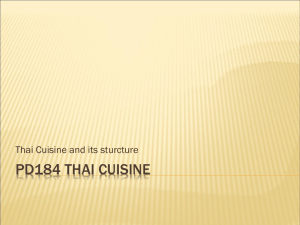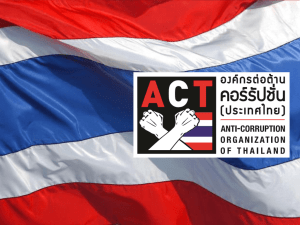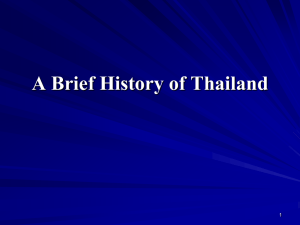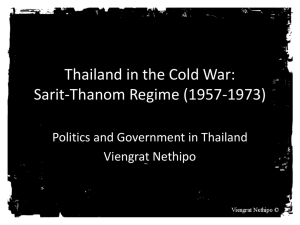Factor influencing Thai cuisine
advertisement
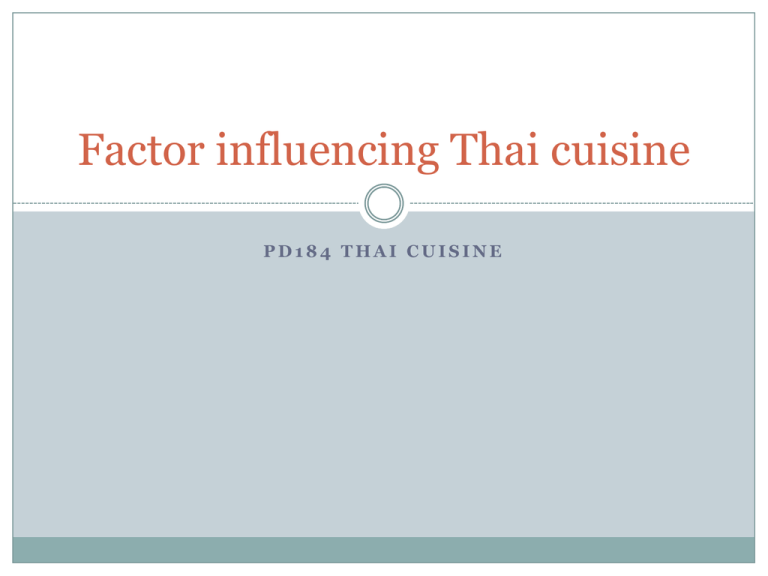
Factor influencing Thai cuisine PD184 THAI CUISINE Conclusion of the last five weeks The principle underlying the structure of Thai cuisine 1.0 Buddhism 2.0 Monarchy 3.0 Geography 4.0 Faith and beliefs 5.0 Social Values 1.0 Buddhism Taking lives is the most serious sin of all. Bad Karma The bigger animal the greater sin. ‘Present’ Thomson suggests that belief in present is the fundamental motivation behind the skilled Thai craftsmanship; especially in cuisine 1.0 Buddhism Religion : Buddhism Making merit to monks: daily obligation Food must be the best, the first and cooked with the best intention. Monks are the intermediaries in sending food to their ancestor ( Sukpisit, 2000) 10 things that can not give to monks Human flesh Dog meat Elephant meat Horse meat Snake meat Lion & Beameat Tiger: leopard, Sumartra, yellow tiger Plus no raw meat, fish, No blood, No alcohol Paradox of Buddhism One of the principles of Buddhism teaching is ‘Not to desire’ However to give merit or to cook at religious ceremony is based on the best ingredients, the most flavour food and the most beautiful looking dish. 2.0Monarchy Dominate the governing style of the country Khmer and Indian influence; status Court cuisine must match the status of the ruler. Taste as well as sight is valued; Craving Lady of the court tries to impress the kings; plenty of time in their hands. Court cuisine underlies the complexity of Thai cuisine. Monarchy Court is the hub of exchanges; food stuffs and cooking techniques. Learn from foreign chef hired by the king Accompany the kings to other places and incorporate different ingredients 3.0 Geographical location Trading route in Asia Foreign plant, spices, foodways came into Siam with trader Turn whatever came in to suit Siamese likeness Indian & Chinese Geographical area Weather pattern of regional area Availability of natural resources Interior geographical characteristic Vs Coast line in the southern part of Thailand Geographical area Tropical zone Heat spoil food Fermented came in handy The use of spices Dried and fermented food stuffs 4.0 Faith and belives Spirits inhabits everywhere God inhabits in foodstuffs teaches Thai not to waste. Do you what kind of food stuffs has faith and beliefs attached to them? Faith and belief Rice godness Phra mea pho sok Water godness Pra mea kong ka Banana tree spirit Phi tanee The habit of not wasting food but creating new dishes from left over is another foundation of Thai cuisine. Ie. Khao tuu, Nahm phrik long rue 5.0 Social values High value placed on forienger ( King Rama V, VI) The fear of colonialism Less impact on the cuisine but more on consuming habits Social values Also, reflecting in wine dinning behaviour Expensive produces ie, oyster, foie gras etc. Check out Sunday brunch The development of Thai cuisine The attempt to modernize Thailand (Rama V,VI) The end of absolute monarchy Governmental policies The declination of power of Buddhism Technology, economy & social changes The attempt of Modernization of Thailand In Rama V and VI The fear from colonised, Siam force to adopted western idea of civilisation Cutlery Court lady learnt how to cooked western food ( to suit Siamese palate) Western ingredients like butter, ham, milk is widely adopted in cooking The end of absolute mornachy Rama the VI abandon the practice of polygamy. Number of royal family member decline The abdicate of Rama VII Disperse of court cuisine Simplified to suit peasant lifestyle Government gain more power in affecting Thai foodways. Political and Governmental moment 1932 Prime minister General Pibul attempted to form a national identity. Telling people how they should eat, act, dress and live After the world war II, there was a rice shortage, the government all encourage thai to eat noodle and Pad Thai Governmental moment Prime Minister Taksin market Thai cuisine as national product. Thai cuisine, cuisine of the world Training and sending chef aboard Governmental moment Standardisation of recipes Use commercial industrialized products from Thailand Declination of Buddhism power Especially with Urban thai Live cycle used to circulate around the temple Religious ceremony every fortnight The central of life shifted Taking advantages of the faith Buddhism declination Eating large animal is become more acceptable Live animal is kept in the tank ready to cooked and served in Chinese restaurants Making merit is not as strict Food normally purchased due to time limitation Technology, Economy and Social changes Urbanization is structural changes from low density to high density residence Primary producers became consumers Move away from indigenous plants & food to purchasing mass produced food by others. Social changes Time scare & double earning push family to depend on market ready-to-eat food. The passing on the knowledge from generation to the next Gender status is changed Technology Canned coconut cream Pre-package curry paste Kitchen equipment and utensils Chilling technology Microwave invention Food innovation Fresh food to process one Festive food available everyday Salih K. et al,. States that ‘ Industrial palate refers to the growing share of value-added, often mass-produced, processed food products in the diet of average conusmer. In conlcusion,.... In my opinion, The being of Thai cuisine is reflected through Thai flag. The balance of texture and flavour Ripe Vs Unripe Spicy Vs Plain Sour Vs Sweet Le Vs Cripsy Undercooked vs Cooked Where is that come from? Influences analyzed Utilizing Rozin’s Structure of cuisine 1. Basic Food stuffs 2. Seasonings and Flavouring Particles 3. Cooking Methods and techniques Basic Food stuffs Rice Rice is the main staple of Thai cuisine. Although consuming rice does not emerge from the influence of other cuisines, the other products made from rice such as noodles and/or fermented rice noodles do so. Thais rarely process rice grains to make other things except its flour for sweet desserts. Rice the staple However, Thais consume processed rice in great amounts today. Noodles for example, are a basic staple that is processed from rice The noodles discussed here are fermented rice noodles as opposed to the noodles introduced by the Chinese. Rice product Fermented rice noodles are consumed throughout Thailand and are believed to have originated in either Myanmar or Cambodia. There is no actual evidence to prove its origin; however, Hongwiwat assumed that it originated in the Mon (Myanmar) and spread to other places in south east Asia. The names given to this fermented rice noodles by south east Asians are interestingly similar In Myanmar, they called it Ka-noan Jin; in Cambodia, Kao nom; and in Thailand Khanomchin. It is closely linked with religious and festive food since it requires many people to prepare, Fermented rice noodles are consumed in every region but with different varieties of curry or spicy soups. (Tawithong Hongwiwat,) Aquatic Food Sources The old Thai cookbook Mae Krau Hua Pa, mentions about forty different fresh water fish that were consumed consistently in the Thai diet agricultural industry damaged the bio-diversity of fresh water fish and vegetables in Thailand, especially in Bangkok. One example illustrating this case is Kaeng Tepho (curry with oily fish and morning glory), whose main ingredient is Tepho, a very oily fresh water fish. Even though Tepho has started to disappear from the dish altogether and has been replaced by pork belly, Thais still call it Kaeng Tepho. What’s interesting here is that the substitute for oily fish was not another type of fish but pork which was a food introduced by the Chinese. Plants, Vegetables and Fruits. Blanched vegetables are the staple condiment to accompany chilli relishes. Thais used to picked these vegetables from paddy fields and when these paddy fields disappeared in Bangkok, the major source of food supply fell onto the agricultural industry .Today local and native vegetables are fading away from Thai dishes in Bangkok. Local green Wildly grown vegetables have changed to more accessible vegetables such as baby corn, cucumber and snow peas. What is most curious is the carrot. How did the carrot make its way into Thai food? (Yasmeen, 344.) Seasonings Lemongrass, kaffir lime, and wild turmeric seem indigenous to Thailand. Onion, spring onion, and shallot are not only used as seasoning but also as vegetables Seasoning and individual flavour ic Dried spices Spices Spices such as cumin, cloves, cardamom, nutmeg, and cinnamon are used limitedly in Matsaman curry paste. Only cumin is the ingredient used in other curry pastes. Cumin is added to give a subtle aroma and flavour to the dish; in fact most of the time it is undetectable. Coriander Coriander has an important role in Thai cuisine. Although coriander leaves are mostly used as a garnish on finished products, coriander underlies Thai cuisine. Coriander roots, which provide a unique aroma and flavour, are essential to many curry pastes and dips. Chilli Chilli is a prime evidence of the fusion of Thai cuisine. Before the introduction of the chilli, Thais depended on the peppercorn as a source of spice in their cuisine. Chilli raised the level of heat and temperature in Thai cuisine and now it is what Thai cuisine is renowned for. Every region uses chilli according to their local tastes. Chilli indeed, creates another flavourful dimension in Thai cuisine. Professor Ake-kaphol creates a chart on the structure of Thai cuisine Salt + chili Basic Dipping Basic Dipping + herb Chili relish Chili relish + meat+ vegetable Salad; yum, pla, Labb Salad + water, coconut oil. Curry Coconut Coconut milk is one of the main ingredients found in Thai dishes including desserts. Sombat Plainoi mentions that grated coconut meat represents a major characteristic of Thai desserts. Coconut Curry paste is fried with coconut milk to create the floating oil. Coconut milk is added to many dishes to create another dimension. This can be seen in dishes such as, the wing bean salad or the blanched vegetables for chilli relish condiments. Fish Sauce, Shrimp Paste, and Soy Sauce Shrimp paste, known as Blachan in Malaya, Nga pi in Burmese and Kapi in Thai is another essential element in Thai curry paste. Thais adopted the word ngapi from Myanmar and gradually shortened it to Kapi which interestingly means monkey in Indian The shared culture in South East Asia … Soy sauce Soy sauce evidently shows the influences from the Chinese and Japanese. Currently, soy sauce is widely used as a seasoning as well as a colouring agent in marinated foods. Soy sauce is often added to intensify the colour of food such as grilled chicken, deep-fried garlic with pepper pork ribs and spicy stir-fried broad rice noodles (Phat Khi mao). Check out food magazine Cooking Methods and techniques Tom Yam Tam and Kaeng is a Thai phrase reflecting Thai cooking technique. Tom means to boil, yam means to create a spicy salad, tam is to make or cook while kaeng is to cook something saucy or soupy. These are the major elements of Thai cooking techniques along with roasting and grilling. Thai cooking methods are not complex, however what is complex is the preparation of the food. Fry Frying and Deep frying The Chinese (and some Christians) farmed and sold pork in Thailand. This was when Thais first learned how to use oil in their cuisine. Thai cuisine today is mostly prepared deep-fried and stir-fried. Examples of these are: deep-fried rice cracker, prawn cracker, fish cake, Pla duk fuu (deep fired shredded fish flesh), mee krop (crispy rice noodles). Stir-fry Brennan suggests that stir-frying, adopted from the Chinese, is one of the main cooking techniques that shaped Thai cuisine. . Stir-fry is present in almost all aspects of Thai cuisine. The list of Thai food prepared this way is long. To name a few examples: fried rice; fried morning glory; water mimosa and other vegetables; stir-fried holy basil with tofu, meat and seafood; garlic and pepper or chilli and ginger both with either meat or seafood. (Brennan, 21) Steaming Although the technique employed to cook glutinous rice in the north and northeast of Thailand is similar to steaming, the utensils, techniques, and purposes are different. The Chinese introduced the traditional steamer at the same time as the wok. The traditional steamer is a stainless steel pot with holes as opposed to the conical shaped bamboo basket steamer used in Thailand Steaming Steamed rice as mentioned in menus found in Thai restaurants is not actually steamed. The cooking rice technique is called ‘Hung’ which simply means to boil until the rice absorbs all the water. Real steaming is cooking using hot vapours. Rice cooker: Mor hung khao Questionnaire
